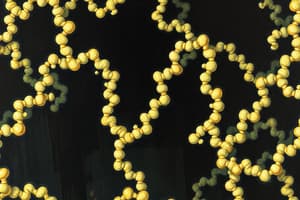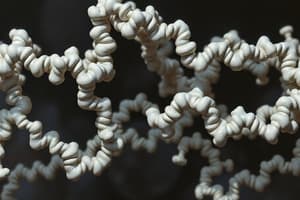Podcast
Questions and Answers
What distinguishes proteins from other organic compounds?
What distinguishes proteins from other organic compounds?
- They are synthesized exclusively from glucose.
- They are always soluble in water.
- The consistent presence of nitrogen as a characteristic component. (correct)
- They are primarily composed of carbon, hydrogen, and oxygen.
Why is the spatial arrangement of amino acids crucial for protein function?
Why is the spatial arrangement of amino acids crucial for protein function?
- It determines the protein's color.
- It influences the protein's solubility in lipids.
- It dictates how the protein interacts with other molecules. (correct)
- It affects the protein's synthesis rate.
Under what circumstances would an amino acid be classified as 'conditionally essential'?
Under what circumstances would an amino acid be classified as 'conditionally essential'?
- When it can only be obtained from genetically modified foods.
- When the body's requirement exceeds its synthesis capacity due to stress or illness. (correct)
- When it is essential for only a subset of the population.
- When it is required for the synthesis of non-protein compounds.
How does the genetic code ensure that the amino acids are correctly arranged in a polypeptide chain?
How does the genetic code ensure that the amino acids are correctly arranged in a polypeptide chain?
Which aspect of protein structure is most directly stabilized by hydrogen bonds between amino and carboxyl groups of amino acids?
Which aspect of protein structure is most directly stabilized by hydrogen bonds between amino and carboxyl groups of amino acids?
What implications does the denaturation of a protein have on its biological activity?
What implications does the denaturation of a protein have on its biological activity?
What role do plasma proteins serve in maintaining blood's osmotic pressure?
What role do plasma proteins serve in maintaining blood's osmotic pressure?
Which of the following roles of amino acids is most directly linked to the synthesis of thyroid hormones?
Which of the following roles of amino acids is most directly linked to the synthesis of thyroid hormones?
What is the primary feature that distinguishes 'acidic' amino acids from 'basic' amino acids?
What is the primary feature that distinguishes 'acidic' amino acids from 'basic' amino acids?
Why are hydrophobic amino acids predominantly located in the interior of a protein molecule?
Why are hydrophobic amino acids predominantly located in the interior of a protein molecule?
Which of the following amino acids possesses a side chain capable of forming disulfide bonds?
Which of the following amino acids possesses a side chain capable of forming disulfide bonds?
How does the presence of proline in a polypeptide chain influence its secondary structure?
How does the presence of proline in a polypeptide chain influence its secondary structure?
What distinguishes glucogenic amino acids from ketogenic amino acids?
What distinguishes glucogenic amino acids from ketogenic amino acids?
Which of the following is a primary function of amino acids other than serving as building blocks for proteins?
Which of the following is a primary function of amino acids other than serving as building blocks for proteins?
What is the significance of the urea cycle in the context of amino acid metabolism?
What is the significance of the urea cycle in the context of amino acid metabolism?
How does the absence of rings in the side chain of an aliphatic amino acid influence its properties?
How does the absence of rings in the side chain of an aliphatic amino acid influence its properties?
What is the chemical basis for classifying amino acids as aliphatic?
What is the chemical basis for classifying amino acids as aliphatic?
In what biochemical process are the branched-chain amino acids (BCAAs) particularly important?
In what biochemical process are the branched-chain amino acids (BCAAs) particularly important?
What is the key structural feature of hydroxy amino acids that contributes to their polarity?
What is the key structural feature of hydroxy amino acids that contributes to their polarity?
How would the absence of sulfur-containing amino acids in an organism's diet most likely affect protein structure and function?
How would the absence of sulfur-containing amino acids in an organism's diet most likely affect protein structure and function?
Which of the following statements would most accurately explain what Heterocyclic amino acids are?
Which of the following statements would most accurately explain what Heterocyclic amino acids are?
In acidic amino acids, what is the significance of having more carboxyl groups than amino groups?
In acidic amino acids, what is the significance of having more carboxyl groups than amino groups?
What characteristic is shared between Arginine, Lysine and Histidine?
What characteristic is shared between Arginine, Lysine and Histidine?
Which characteristic would allow a biochemist to determine which metabolic classification an amino acid has?
Which characteristic would allow a biochemist to determine which metabolic classification an amino acid has?
In cases of malnutrition or specific genetic disorders, why are some non-essential amino acids still supplemented in the diet?
In cases of malnutrition or specific genetic disorders, why are some non-essential amino acids still supplemented in the diet?
What implications arise from mutations that affect the synthesis or structure of essential amino acids within a plant used for human consumption?
What implications arise from mutations that affect the synthesis or structure of essential amino acids within a plant used for human consumption?
Which of the following best describes the primary way that the human body sources its supply of essential amino acids?
Which of the following best describes the primary way that the human body sources its supply of essential amino acids?
Flashcards
Proteins
Proteins
Organic nitrogenous compounds that consist of L-α-amino acids united by peptide linkages.
Amino Acids
Amino Acids
Building blocks of proteins that contains an amino group and a carboxyl group.
Peptide Linkage
Peptide Linkage
A bond that links amino acids in a protein.
R-group
R-group
Signup and view all the flashcards
L-amino Acids
L-amino Acids
Signup and view all the flashcards
Chiral Carbon
Chiral Carbon
Signup and view all the flashcards
Optically Active
Optically Active
Signup and view all the flashcards
Protein Synthesis
Protein Synthesis
Signup and view all the flashcards
Enzyme and Hormone Production
Enzyme and Hormone Production
Signup and view all the flashcards
Neurotransmitter Synthesis
Neurotransmitter Synthesis
Signup and view all the flashcards
Immune Function
Immune Function
Signup and view all the flashcards
Acid-Base Balance
Acid-Base Balance
Signup and view all the flashcards
Detoxification
Detoxification
Signup and view all the flashcards
Transport and Storage of Nutrients
Transport and Storage of Nutrients
Signup and view all the flashcards
Wound Healing and Tissue Repair
Wound Healing and Tissue Repair
Signup and view all the flashcards
Signaling Molecules
Signaling Molecules
Signup and view all the flashcards
Energy Production
Energy Production
Signup and view all the flashcards
Chemical Classification
Chemical Classification
Signup and view all the flashcards
Biological/Nutritional Classification
Biological/Nutritional Classification
Signup and view all the flashcards
Metabolic Classification
Metabolic Classification
Signup and view all the flashcards
Neutral Amino Acids
Neutral Amino Acids
Signup and view all the flashcards
Aliphatic Amino Acids
Aliphatic Amino Acids
Signup and view all the flashcards
Aromatic Amino Acids
Aromatic Amino Acids
Signup and view all the flashcards
Sulfur-Containing Amino Acids
Sulfur-Containing Amino Acids
Signup and view all the flashcards
Heterocyclic amino acids
Heterocyclic amino acids
Signup and view all the flashcards
Acidic Amino Acids
Acidic Amino Acids
Signup and view all the flashcards
Basic Amino Acids
Basic Amino Acids
Signup and view all the flashcards
Glucogenic Amino Acids
Glucogenic Amino Acids
Signup and view all the flashcards
Ketogenic Amino Acids
Ketogenic Amino Acids
Signup and view all the flashcards
Mixed amino acids
Mixed amino acids
Signup and view all the flashcards
Study Notes
- All amino acids that the body needs are important
- Not all amino acids that enter the body are used to synthesize proteins; some have other functions
Objectives
- Define amino acids, and describe their general structure
- Classify amino acids based on their chemical, biological, and metabolic properties
- Differentiate between essential, non-essential, and conditionally essential amino acids
- Describe the different levels of protein structure
- Explain the concept of protein misfolding and its role in diseases like Alzheimer's, Parkinson's, and prion diseases
- Discuss the significance and applications of protein denaturation in biological and medical contexts
- Identify the types of bonds stabilizing protein structures
- Describe the classification of proteins
What Are Proteins?
- Proteins are organic nitrogenous compounds consisting of L-alpha-amino acids united by peptide linkages
- Proteins are composed of carbon, hydrogen, oxygen, and nitrogen; many also contain sulfur
- Nitrogen is a characteristic component, forming 16% of protein weight
Biological Importance of Proteins
- Proteins play a nutritional role
- Proteins play a catalytic role as all enzymes are proteins in nature
- Most hormones and all cellular receptors are protein in nature
- Antibodies (immunoglobulins) are defensive proteins playing a key role in the body's defensive mechanisms
- Plasma proteins are responsible for the effective osmotic pressure of the blood
Amino Acids
- Amino acids are organic acids containing an amino group and a carboxylic group (COOH)
- They serve as the building units of proteins
- Mammals have L-amino acids where the amino group is on the left side configuration
- A carboxylic group (COOH) and an amino group (NH2) are both attached to the α-carbon.
- Each amino acid has a characteristic side chain (R)
- Although approximately 500 amino acids exist in nature, only 20 can polymerize in protein structures
- There is a specific codon in the genetic code for each amino acid
- All amino acids are optically active, except glycine
Functions of Amino Acids
- Protein synthesis: building blocks for protein, essential for growth, repair, and maintenance
- Enzyme and hormone production: many are made from amino acids like insulin and glucagon, and regulate metabolic processes
- Neurotransmitter synthesis: some amino acids are precursors to neurotransmitters, for example, tryptophan for serotonin and tyrosine for dopamine
- Immune function: certain amino acids like glutamine and arginine support immune cell function/response
- Acid-base balance: amino acids maintain pH balance by acting as buffers
- Transport and storage of nutrients: such as albumin and hemoglobin transport molecules like oxygen, iron, and nutrients
- Wound healing and tissue repair: Amino acids like arginine and proline promote collagen formation and tissue healing
- Detoxification: amino acids assist in removing toxins from the body such as is seen in the urea cycle
- Signaling molecules: amino acids and their derivatives function as cell signaling molecules, for example, nitric oxide from arginine
- Energy production: amino acids can be used as an energy source through gluconeogenesis or direct oxidation when needed
Nomenclature
- Each amino acid has a three-letter abbreviation and a one-letter code
Classification of Amino Acids
- Amino acids are classified based on (A) chemical, (B) biological/nutritional, and (C) metabolic classifications
- Chemical classification is based on the number of amino groups or carboxyl groups
- Chemical classification includes neutral, acidic, and basic amino acids
- Biological/nutritional classification is based on whether the amino acids can be synthesized in the human body or not
- The types of biological/nutritional classification include essential and non-essential amino acids
- Essential amino acids cannot be synthesized and must be supplied in the diet
- Non-essential amino acids are synthesized, so they don't need to be present in the diet
- Metabolic classification is based on the fate of the amino acid inside the body
- The types of metabolic classification include: glucogenic, ketogenic, and mixed amino acids
- Glucogenic amino acids can be converted to glucose
- Ketogenic amino acids can be converted to ketone bodies
- Mixed amino acids can be converted to glucose and ketone bodies
Neutral Amino Acids
- Neutral amino acids contain one amino group and one carboxyl group
- Classes of neutral amino acids:
- Aliphatic: straight or branched hydrocarbon side chains without rings (glycine, alanine, valine, leucine and isoleucine)
- Non-polar and hydrophobic, so they are found in protein structure away from water
- Branched chain amino acids: valine, leucine and isoleucine
- Hydroxy: contain -OH groups (serine and threonine)
- Polar
- Sulfur-containing: contain sulfur atoms (cysteine, homocysteine, cystine, and methionine
- Aromatic: contain aromatic rings (phenylalanine, tyrosine, and tryptophan)
- Heterocyclic: contain rings other than benzene (tryptophan, histidine, and imino acids (proline and hydroxyproline))
- Aliphatic: straight or branched hydrocarbon side chains without rings (glycine, alanine, valine, leucine and isoleucine)
Acidic Amino Acids
- Acidic amino acids contain two carboxyl groups and one amino group (Glutamic acid and Aspartic acid)
Basic Amino Acids
- Basic amino acids contain one carboxyl group and two amino groups (Arginine, Citrulline, Ornithine, Lysine and Hydroxylysine)
Metabolic Classification
- They are classified based on the metabolic fate of the amino acids, whether they are converted into glucose or ketone bodies
- Glucogenic amino acids can be converted into glucose
- Examples of Glucogenic amino acids: Alanine, Aspartate, Serine, Glycine
- Ketogenic amino acids can be converted into ketone bodies or acetyl-CoA
- Leucine is the only pure ketogenic amino acid
- Both glucogenic and ketogenic (Mixed) amino acids can be metabolized into both glucose and ketone bodies, depending on the conditions
- Examples of Glucogenic and Ketogenic Amino Acids: Lysine, Isoleucine, Phenylalanine, Tyrosine, and Tryptophan
Biological or Nutritional Classification
- They are classified based on their nutritional requirements
- Essential amino acids cannot be synthesized and must be obtained through diet, muscle building, enzyme function, hormone synthesis, and tissue repair
- Source: animal proteins (milk, egg, meat, liver, fish, chicken) and a few plant proteins (bean and lintels)
- Valine, Isoleucine, Threonine, Tryptophan, Arginine, Leucine, Lysine, Methionine, Phenylalanine, Histidine
- Conditionally essential amino acids are non-essential under normal conditions but can become essential during times of stress, illness, or metabolic disorders
- May occur when the body may not be able to synthesize these amino acids in sufficient amounts during illness or trauma
- Arginine and histidine are examples
- Non-essential amino acids can be synthesized by the body from other molecules, and their deficiency does not affect growth or health. -The rest of amino acids fall into this category
Studying That Suits You
Use AI to generate personalized quizzes and flashcards to suit your learning preferences.





